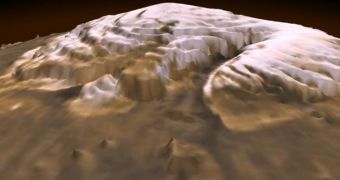New radar investigations with NASA's Mars Reconnaissance Orbiter probing the north pole of Mars revealed that the Red Planet is much colder than previously believed, meaning that any previous hope of finding liquid water near the surface of the planet has been shattered. Nevertheless, liquid water could still be available on Mars, only at larger depths than expected, where the temperatures would rise slightly in response to the proximity to the core of the planet.
Probing results show that the northern ice cap of Mars is about 2 kilometers thick and expands over an area of land measuring 800,000 square kilometers. The polar cap itself is composed of four distinctive layers of ice, sand and dust separated by a layer of clean ice. Each of the layers measures 300 meters in thickness. The pattern was most likely created by alternating dust storms and icy eras, generated by the planet's tilt and possible anomalies in its orbit around the Sun.
"All this layering is key evidence for theoretical models that predict that changes in Mars' climate are coupled with orbital changes", said researcher Roger Phillips, a geophysicist at Southwest Research Institute.
The results of the radar investigation also showed that the layer beneath the ice cap does not deform under the massive weight of the ice sitting on top of it, meaning that Mars' crust could be as thick as 300 kilometers.
"Mars might be colder than we thought. If one thought that liquid water was 5 kilometers deep (3 miles), it's now at least 30 percent deeper than that", Phillips said.
However, the reason why the Red Planet is so cold remains a mystery. Phillips believes that it could be due to the fact that it lacks heat-producing elements such as uranium and thorium, or maybe the crust in the polar areas is much thicker, while in other areas it's much thinner and hotter such as in the areas around Tharsis and Elysium.
NASA's Phoenix Mars Lander is expected to land in Mars' south polar regions on May 25 and will conduct investigations regarding the water ice beneath Martian arctic soil, to reveal what caused the ice layering at the north pole and the heat flow over the planet.

 14 DAY TRIAL //
14 DAY TRIAL //